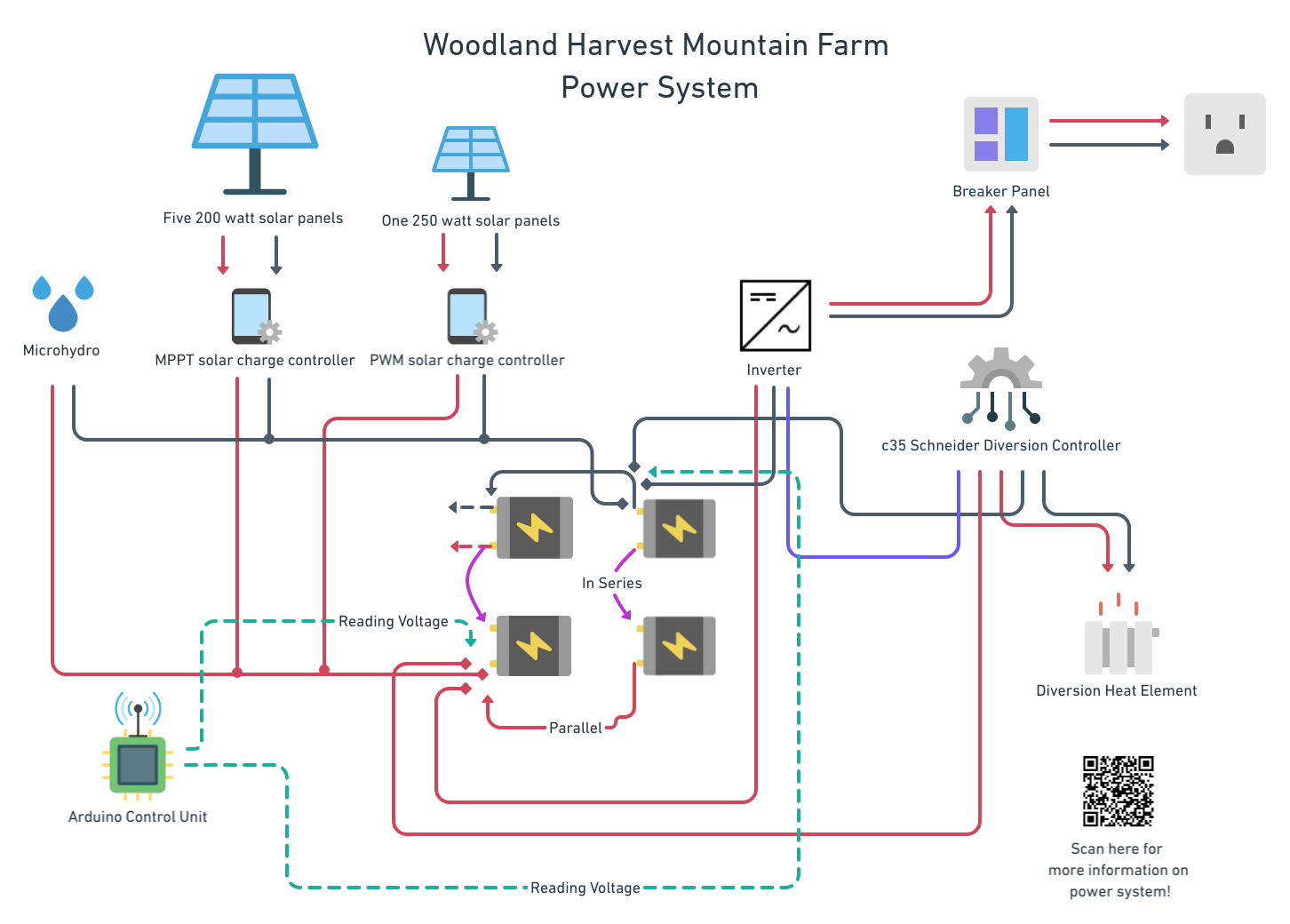Main House Electricity System
The electricity system consists of a set of four deep cycle batteries, an inverter, the Main 1000 W Solar System, one 250 W solar panel, an MPPT charge controllers for the five solar panels, a 70 W Micro Hydro Turbine, and a diversion controller.
Solar Panels and MPPT Charge Controller
There are five SUNGOLDPOWER 24V Monocrystalline 200W Solar Panels(62.2 x 31.8 x 1.4 inches) that are connected in parallel, which keeps their voltage at 24 V and adds up their amperage. On a sunny day, they output up to 500 W to the SolarEpic 4125BN MPPT Solar Charge Controller. The charge controller is rated for 40 A.
The additional, older 250 W panel is connected to a small PWM charge controller. Note that PWM charge controllers are less efficient than MPPT controllers.
For more information on the solar panel upgrade that was done, please refer to Additional Solar Panels Research.
Wires and Connectors
We are using around 100 feet of 2 AWG copper cable for each positive and negative connection. The cables are NOT fully water-resistant. Ideally, we should bury them in PVC pipes underground. The SUNDGOLDPOWER panels used to have standard MC4 connectors that we cut off.
Mounts and Brackets
SunWize has a large number of solar panel connectors and brackets. Solar Electric has pole mounts.
Angles for mounting: - February 5th – Set to same angle as your latitude. - May 5th – Set at the same angle as your latitude minus 15 degrees. At noon the panel will be almost horizontal to the ground. - August 5th – Set at the same angle as your latitude. - November 5th – Set at the angle of latitude plus 15 degrees. This tilts your panels towards the sun as it travels low in the southern sky during the winter.
Our latitude is 36.4037°.
Micro-Hydro and Diversion Controller
The micro-hydro system outputs around 60 W all day long. We currently don't have any accurate information on its original efficiency, head, or other characteristics. Please update this section and the micro-hydro page if you know more.
As the micro-hydro system charges the batteries 24/7, it is important to prevent overcharging with a diversion controller that redirects the energy to a heating element. The heating element dumps the electricity and converts it into heat. The diversion controller is the C-35 by Schneider (Manual).
The Hydro is currently connected through a digital multi-function meter that displays the volts, amps, watts, and watt hours. The display diagram is (here).
Inverter
The current inverter's maximum continuous battery charger input is 3600VA. It's maximum alternating current (AC) output overcurrent protection is 35 A at 110 V.
Deep-Cycle Batteries
The main house has a 24 Volt [V] deep-cycle battery system with a capacity of 420 Ampere-hours [Ah]. The battery system consists of four deep cycle batteries of the type 12 FS 210 by Rolls Battery (data sheet). Each individual battery has an output voltage of 12 V and a capacity of 210 Ah at a discharging rate of 20 hours (please check datasheets for lower discharging rates). The four batteries are parallel- and series-connected, which doubles the system’s voltage and capacity.
As with all deep cycle batteries, they shouldn’t be drained to less than 20% of their capacity, which results in a usable capacity of 336 Ah with 24 V (~8,000 Watt-hours [Wh]) after purchase. Please note that these numbers will be lower after long-term usage. Based on experience, the batteries are severely damaged resulting in a capacity of approx. 40% (3,200 Wh).
Upgrading the Batteries
One should refrain from adding new batteries to an already used set as it wears down the old batteries faster. This will result in deep discharged old batteries. Therefore, we could consider moving the current/old set to our future octagonal cabins. As depicted in the illustration above, we could run two independent 12 V systems in different locations. Rolls Battery released a new version of our current batteries, the S12 185 (data sheet). Here is a summary of the model updates.
Software and Hardware
The Main House Electricity System is connected to an Arduino-based Electrical Control Unit. Please refer to the aforementioned page for the GitHub repository.
